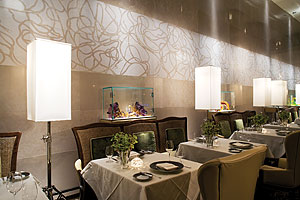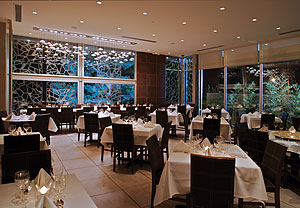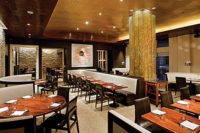
Rafael Alvarez, co-founder of Alvarez-Brock Design in New York, NY, specializes in hotel, restaurant and product design.
Born in the Dominican Republic, Rafael Alvarez is an accomplished architect, graphic designer and painter whose work can be found around the world. A visual arts graduate from the School of Arts Apec (EDA) and Architecture at the Universidad Nacional Pedro Henriquez Urena (UNPHU), he was an Artist in Residence, Art and Design Director and instructor for the Foundation Altos de Chavon - an affiliate of Parson’s School of Design in New York City. Alvarez’s work has been exhibited in museums and galleries internationally and by invitation to the Biennale de Paris, Sao Paulo, Havana and Mexico.
For more than 12 years, Alvarez was Design Director for Tihany Design in New York - working on some of the most internationally recognized projects. His portfolio includes Le Cirque 2000 in New York, NY; Le Cirque in Las Vegas, NV; One CPS, Plaza Hotel in New York, NY; Le Cirque in Mexico City, Mexico; Inagiku, Waldorf Astoria Hotel in New York, NY; Circo in Las Vegas, NV; Spago Chicago for Wolfgang Puck in Chicago, IL; Aleph Hotel in Rome, Italy; Monte’s Club Restaurant in London, England; Amber Restaurant, Landmark Mandarin Oriental Building in Hong Kong, China; The Line, Shangri-la Hotel in Singapore; and Jade & Summit Shangri-La Hotel in Shanghai, China.

The Peking Pavilion in Manalapan, NJ, which was designed by Rafael Alvarez, features 24- x 24-inch metallic tiles on the back wall of its interior design. Tile Manufacturer: Mosa; Tile Distributor: Town and Country, New York, NY
Additionally, Alvarez has given many lectures and received several recognitions for his work through the years. Most recently, he was awarded the “Wave of the Future Award” by Hospitality Design Magazine in Miami, FL; the “Reign of Spain Award” given by the Tile of Spain in 2010; and he was a speaker at the 10th International Architecture Biennial, Museo de arte Moderno, Santo Domingo, Dominican Republic in 2010. Moreover, Alvarez was awarded the Medal of Honor, “Citizen of Merit,” by the Dominican Consulate in New York in 2009, gave the commencement address at the 25th anniversary of Altos de Chavon School of Design’s graduation, La Romana, Dominican Republic in 2010, and was on the jury in the 8th International Architecture Biennial, Museo de Arte Moderno in Santo Domingo in 2006.
Recently, Contemporary Stone & Tile Design had the opportunity to speak with Alvarez about his work, and in particular, the use of stone and tile in design:
CSTD:How would you describe you firm’s design philosophy?
Alvarez:As a company, we don’t have a style. We design, and depending on the problem, we get a solution. A design is not put in a box that you have had before. Someone is hiring us for a solution, and we can give a top design for their project. Otherwise, you wake up and every day will be the same. There’s always a new challenge. We try to make something new in every project. Sometimes, it is not the whole project, but some detail or some fixture that is new. This is how I like to see it. I like to challenge myself. I say that if you always know the answer, then you are repeating yourself.

“I like to change the stone in different ways,” said Alvarez. “For a restaurant called Lucier in Portland, OR, I used limestone for a 60-footlong wall. I had the stone polished first, and then on some of the stone pieces I glued on the lines from my drawing and had the stone sandblasted.” Stone Supplier: Town and Country, New York, NY
Alvarez:There are seven people. We are a small company with big projects, which is why we don’t take that many projects in a year. My partner and I want to be hands-on with every project. Our clients get full service from us. They don’t pay us to get an intern. This is the way we prefer to do it.
CSTD:How many projects do you typically work on in a year?
Alvarez:We average five to seven projects a year - sometimes you take something small for fun. If it is something exciting, we do it. We don’t just do something to put on our Web site.
CSTD:Do you often use stone and tile in your designs?
Alvarez:I have to say, 10 years ago, people were just putting tiles in the bathroom. These days, there are all new [tile] designs. It looks like a new material. My favorite is a metallic tile that I am using in a Chinese restaurant in Manalapan, NJ. The restaurant is called Peking Pavilion, and we are using the tile in 24- x 24-inch format on the back wall.
Now we see so many beautiful materials. There are so many tiles. I saw one the other day that was 7 feet long by 5 feet wide. It’s amazing. You can do floors in ceramic tile that look like stone and wood, and the maintenance is lower.
I like to use stone [also]. It is the only material that proves in history that it can stay there. I am doing a hotel/spa/restaurant in Beijing now, and everything is stone. Stone has a history behind it. It doesn’t have to prove anything. Tile is a newcomer.
I like to change the stone in different ways. For a restaurant called Lucier in Portland, OR, I used limestone for a 60-foot-long wall. I had the stone polished first, and then on some of the stone pieces, I glued on the lines from my drawing and had the stone sandblasted. The limestone was also used on the bathroom walls in 2- x 6-foot pieces.
CSTD:With the growing trend in green building, do you use many green products in your designs?
Alvarez:The first time I saw recycled material, I thought it looked so ugly. It was in a hotel in Hong Kong. Okay, it’s great that everything is being recycled and it is natural, but I thought, “Why does it have to be ugly?” I call that a “recipe for design.”

The limestone was also used on the bathroom walls in 2- x 6-foot format.
These days, more and more, there is a trend of going green. I’m working on a project right now in the Caribbean, and we are using a lot of green products. If it is a quality material, it is fine.
I would love to use a [Spanish] tile with growing plants [that I saw]. It’s so expensive to use it though. True, it will breathe, but at what price? One of the things we do in our company is to protect our clients. We don’t just spend their money. We are always conscious of that.
CSTD: What project are you working on in the Caribbean?
Alvarez: There are two restaurants in the Dominican Republic. For one of the restaurants, the whole front of building is made of ceramic tile. I realized when I started to design the building for these projects, that the tradition [in the Caribbean] was very normal to use ceramic tile in the front of the building and for the roof. Using it on the roof keeps the heat away from the building, which helps when they don’t have air conditioning.
CSTD: How do you typically go about the stone/tile selection process for a project?
Alvarez: When I start a project, I start to think about materials - sometimes from what I read, sometimes from what I see. I like to put together a palette of colors. I like stone, wood - I like everything. I get a fresh idea of the tones of colors, and then develop from there.
We pick all materials here in our office. When some companies hire a certain firm, they know what to expect because they are known for using specific things. We don’t have that here. Sometimes, materials have something to do with the country or place.
Also, I ask for samples. Sometimes I go through a magazine. I often am introduced to new products from suppliers that I have known for a long time. They bring me new things. They will call me and ask, “Do you have five minutes?” They will come to the office and ask if I have an interest in what they are showing me. This is how we work. We have a big library in the office. Sometimes, you have an idea in your mind of what you want, and when you have a sample, it is very easy to put together. I have a rule - if you don’t like something, don’t keep it. Pay attention to something that is of interest to you. We get excited about tile and stone.
I would love to use a [Spanish] tile with growing plants [that I saw]. It’s so expensive to use it though. True, it will breathe, but at what price? One of the things we do in our company is to protect our clients. We don’t just spend their money. We are always conscious of that.
CSTD: What project are you working on in the Caribbean?
Alvarez: There are two restaurants in the Dominican Republic. For one of the restaurants, the whole front of building is made of ceramic tile. I realized when I started to design the building for these projects, that the tradition [in the Caribbean] was very normal to use ceramic tile in the front of the building and for the roof. Using it on the roof keeps the heat away from the building, which helps when they don’t have air conditioning.
CSTD: How do you typically go about the stone/tile selection process for a project?
Alvarez: When I start a project, I start to think about materials - sometimes from what I read, sometimes from what I see. I like to put together a palette of colors. I like stone, wood - I like everything. I get a fresh idea of the tones of colors, and then develop from there.
We pick all materials here in our office. When some companies hire a certain firm, they know what to expect because they are known for using specific things. We don’t have that here. Sometimes, materials have something to do with the country or place.
Also, I ask for samples. Sometimes I go through a magazine. I often am introduced to new products from suppliers that I have known for a long time. They bring me new things. They will call me and ask, “Do you have five minutes?” They will come to the office and ask if I have an interest in what they are showing me. This is how we work. We have a big library in the office. Sometimes, you have an idea in your mind of what you want, and when you have a sample, it is very easy to put together. I have a rule - if you don’t like something, don’t keep it. Pay attention to something that is of interest to you. We get excited about tile and stone.

For Scampo in the Libirty Hotel in Boston, MA, Alvarez chose a porcelain tile that resembles the look of wood planking. The tile was “Tobacco” from the Havana collection. Tile Manufacturer: Mediterranea
For the restaurant in the Dominican Republic, I was looking for something to blend in with the park where it is located. I was looking through one of the catalogs I have, and I saw these little 1- x 1-inch tiles in a mix of different shades of green. In the park, you have all the trees around. There’s a lot of great color. The green tiles fit in beautifully. I placed the order already.
CSTD:Do you spend much time on site supervising construction?
Alvarez:Yes. That’s the reason we don’t take that many projects. Traveling can become crazy. We are there for every opening - even to make sure the tables and chairs are in the right place. You have to have a relationship with your clients. We have always had a good relationship. You want to be successful on a project.
CSTD:As your firm does a lot of work in the hospitality industry, what are some trends you are seeing today in regards to stone and tile?
Alvarez:These days, some of my friends called it “Burger/Mac and Cheese Design.” I’m not really seeing any trends yet. I’m waiting to see what will change. I think most of the places I see these days look like someone went to the flea market. I call it “Pottery Barn.” It’s like they just went shopping at the store and put things on the walls. Part of the problem is the economy, but the economy means you have to be more creative. When you don’t have money, you have to have great ideas. Many people are doing it the easy way - formula design; that’s my feeling sometimes.
I have an exercise. I am doing a tiny restaurant in New Jersey, with a low budget. A friend of mine came to me and said, “I don’t have a lot of money,” and I said, “I’ll do it.” You have to draw it and think about it and figure out how to resolve it. That was one of the first little challenges that I like to do. How creative can I be with so little money? I think we are even under budget now.



